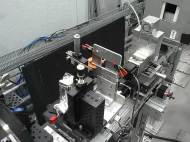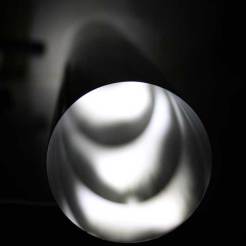Improved neutron-based microscope could lead to new breakthroughs in science
 A group of researchers at MIT cooperated with partners at NASA to develop a new concept for a microscope which relies on particles to create high-resolution images. The fact they decided to use neutrons instead electrons allows the neutron-based microscope to probe inside metal objects — such as fuel cells, batteries, and engines, even when in use — to learn details of their internal structure.
A group of researchers at MIT cooperated with partners at NASA to develop a new concept for a microscope which relies on particles to create high-resolution images. The fact they decided to use neutrons instead electrons allows the neutron-based microscope to probe inside metal objects — such as fuel cells, batteries, and engines, even when in use — to learn details of their internal structure.
“For neutrons, there have been no high-quality focusing devices”, said David Moncton, an adjunct professor of physics and director of MIT’s Nuclear Reactor Laboratory. “Essentially all of the neutron instruments developed over a half-century are effectively pinhole cameras. We are turning the field of neutron imaging from the era of pinhole cameras to an era of genuine optics.”
Since neutrons are considered to have no electrical charge, their interaction with matter is minimal. Unlike electrons, that makes focusing the beams of them difficult, hence you can’t use that approach to create a telescope or microscope. Much like X-rays, neutron beams interact weakly but can be focused by a similar optical system. Mirrors with certain coatings can be used to reflect neutrons at shallow angles, in spite of the neutron’s weak interaction.
In order to increase the surface area available for reflection, the actual instrument uses several reflective cylinders nested one inside the other. According to researchers, the resulting device could improve the performance of existing neutron imaging systems by a factor of about 50 – allowing for much sharper images and reducing the size of the apparatus.
The team initially designed and optimized the concept digitally, then fabricated a small test instrument as a proof-of-concept and demonstrated its performance using a neutron beam facility at MIT’s Nuclear Reactor Laboratory. Later work, requiring a different spectrum of neutron energies, was carried out at Oak Ridge National Laboratory (ORNL) and at the National Institute of Standards and Technology (NIST).
The instrument developed by MIT researchers could be used to observe and characterize many kinds of materials and biological samples. Neutron instruments are also uniquely sensitive to magnetic properties and to lighter elements that are important in biological materials. Because the neutron beams are relatively low-energy, they could be used to investigate how atoms or magnetic moments move in a material.
For more information, read the paper published in Nature Communications: “Demonstration of a novel focusing small-angle neutron scattering instrument equipped with axisymmetric mirrors”.










Leave your response!